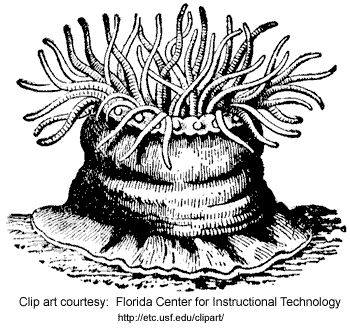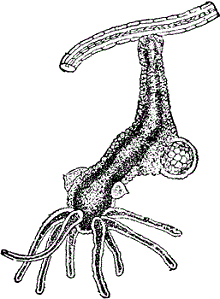 Hydra and Other Cnidarians
Hydra and Other Cnidarians
A common organism to study in a biology lab is the hydra. The hydra belongs to a group of organisms known as cnidarians or sometimes called coelenterates. This phylum also includes animals such as the jellyfish and sea anemone and the organisms that make up coral reefs. The common characteristic to all of these animals is that they have stinging cells located, known as cnidocytes, on their tentacles.
Because they belong to the animal kingdom, you can also assume that all cnidarians are multicellular and heterotrophic - meaning they must consume their food in some way. Many cnidarians spend their lives attached to objects where they wait for fish or other organisms to swim by them and become trapped by their tentacles.
Let's compare the main types of cnidarians. Sea anemones belong to the class Anthozoa, which translates to mean "flower animal". Anemones are often very colorful and have hundreds of tentacles that wave in the water currents while the main part of their body remains attached to a surface. They are pretty to look at, but deadly to fish that swim too close. The fish becomes paralyzed by the stinging cells and eventually is pushed into the anemone's mouth, which is at the center of the tentacles. The main body area contains a gastrovascular cavity, which is like a stomach, where the fish is digested.
Coral is also related to the sea anemone, though organisms in this group tend to be smaller and live in colonies. Coral reefs are actually made from the skeletons of cnidarians that have build up for many years. A coral reef provides a home to many other ocean organisms, such as fish, octopus, crustaceans and even sharks. The Great Barrier Reef off the coast of Australia is the largest coral reef on the planet.
The next group of cnidarians are the Scyphozoans, or jellyfish. These animals can move freely in the water. Basically, if you imagine a sea anemone upside down, then you have a jellyfish. In fact, because cnidarians can come in two forms, they have names for their body plans. The ones that sit on a surface with their tentacles pointing up are called polyps. The ones that swim with their tentacles pointing downward are called medusas. Jellyfish obtain their food in the same way as other cnidarians, by capturing smaller animals with their tentacles. Unfortunately, sometimes swimmers can accidentally come into contact with a jellyfish. In most cases, the sting from their tentacles is painful to humans, but not fatal.
The last group of cnidarians is the Hydrozoans, which includes the hydra. This little organism is found in freshwater and can easily be grown and studied in a biology laboratory. It is large enough to be seen with the naked eye, but if you want to see greater detail, place the hydra on a concave slide and view it under a microscope. You will notice five or six tentacles surrounding the hydra's mouth. Even under low power, you can see the individual bumps on the tentacles that mark the location of the cnidocytes. Like all over cnidarians, the hydra has venom within these stingers used to capture and paralyze prey. At the bottom of the hydra is its basal disk, which secretes a sticky substance for attaching to surfaces. The hydra can still move by floating and also by doing a characteristic cartwheel where it flips over onto its tentacles and then pops back to its original orientation.
You may even be able to see the hydra eat by placing a small organism, such as daphnia or brine shrimp on the slide. When these organisms swim close to the hydra, they will immediately be grabbed by the tentacles and consumed. Because the hydra does not have a separate opening for waste, any material that cannot be digested is regurgitated out of its mouth.
Cnidarians do not have a head or a brain or other organs that we find familiar to animals. It is amazing that they can live, eat, and respond to their environment. Instead of a brain, their bodies have a nerve net, which is used to coordinate their movements and respond to the environment. Most cnidarians can regenerate their tentacles or other damaged body parts. In fact, they can even grow a whole new body attached to their main body. This smaller version of themselves is called a bud and is a form of asexual reproduction.
Part A: - Citation
For each question below, make a notation within the article for where the answer is found. Use the same number a the question. Circle the correct answer.
1. To what kingdom do cnidarians belong? a. Animalia b. Porifera c. Cnidaria
2. What could a hydra eat? a. algae b. brine shrimp c. jellyfish
3. Which of the following remains mostly stationary, attached to surfaces? a. jellyfish b. sea anemone c. hydra
4. A "bud" is formed by a hydra as a means of: a. defense b. swimming c. reproduction
5. Anthozoans were named such because: a. they looked like flowers b. they were found near Anthoa c. they have stingers
6. Which cnidarians is most likely to be studied in a biology class? a. jellyfish b. sea anemone c. hydra
7. Which of the following characteristics are common to ALL cnidarians?
a. stinging cells b. live in oceans c. medusa body form
8. How does a hydra remove wastes or undigested material?
a. exits through an anus b. regurgitated from the mouth c. absorbed through the tentacles
9. Jellyfish belong to the Phylum ______ and the Class ______.
a. Cnidaria, Anthozoa b. Scyphozoa, Cnidaria c. Cnidaria, Scyphozoa
10. What structure allows a jellyfish (and other cnidarians) to respond to its environment?
a. central nervous system b. nerve net c. gastrovascular cavity
Part B: Summarizing
11. In a single sentence, identify the MAIN POINT of the article.
12. Create a VENN diagram of two organisms mentioned in the article which compares and contrasts the characteristics of each.